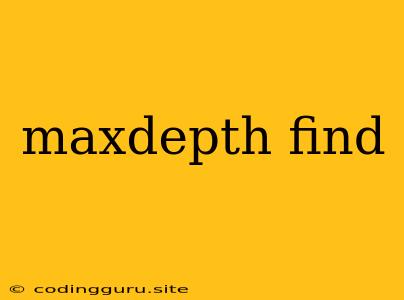Exploring the Depths: Understanding "maxdepth" in File System Navigation
Have you ever found yourself wading through a vast file system, struggling to pinpoint specific files amidst a sea of directories? Navigating through complex file structures can be a daunting task, especially when you're only interested in files within a specific depth level. This is where the "maxdepth" parameter comes in, offering a powerful way to control the scope of your file searches.
What is "maxdepth"?
The term "maxdepth" is often encountered in the context of command-line utilities for file system navigation, particularly within tools like find, grep, and xargs. It essentially acts as a depth limiter, specifying the maximum level of directories to traverse during a search.
Imagine you have a file system organized like this:
/
|- directory1
| |- file1.txt
| |- directory2
| |- file2.txt
|- directory3
|- file3.txt
If you execute a command with maxdepth 1, your search will only explore the immediate children of the root directory (/). This means you would find file1.txt and file3.txt, but not file2.txt which is nested within directory2.
How Does "maxdepth" Work with "find"?
Let's delve deeper into how "maxdepth" functions within the find command. find is a fundamental Unix utility designed for locating files within a given directory hierarchy.
Example:
find /home/user/ -maxdepth 1 -type f -name "*.txt"
In this example, find is tasked with locating all files with the .txt extension within the /home/user/ directory. The -maxdepth 1 parameter restricts the search to the first level of directories below /home/user/, effectively excluding any subdirectories.
Here's a breakdown of the components:
/home/user/: The starting point of the search.-maxdepth 1: The depth limit set to 1.-type f: Specifies that only files (not directories) should be considered.-name "*.txt": The search pattern for files with the.txtextension.
Key Points:
maxdepth 0: This parameter will only search the starting directory, effectively bypassing any subdirectories.maxdepth 1: This option explores one level of directories beneath the starting point.maxdepth N: Here,Nrepresents the maximum depth level to traverse.
Applications of "maxdepth"
The "maxdepth" parameter offers a powerful tool for tailoring your file system searches based on depth. Here are some practical applications:
1. Targeted File Searching: Limit your search to specific directory levels to avoid overwhelming results with irrelevant files.
2. Directory Structure Management: Ensure that directories adhere to a defined depth structure, preventing excessively nested directories.
3. System Optimization: Minimize the time and resources required for file searches, particularly when dealing with large file systems.
4. Security Audits: Restrict security scans to specific depth levels, focusing on sensitive areas within your system.
5. Backup and Restoration: Effectively manage the backup process by limiting the scope of data to be backed up to specific depth levels.
Beyond "find"
While "maxdepth" is commonly associated with the find command, it's also utilized by other utilities for file system manipulation:
grep: Restricting the search for specific patterns within files to certain depth levels.xargs: Controlling the depth of file processing when executing commands based on file search results.
Tips for Efficient Use of "maxdepth"
- Start with
maxdepth 1and incrementally adjust: Begin with a shallow search and gradually increase the depth limit until you obtain the desired results. - Combine with other search criteria: Leverage parameters like
-type,-name,-size, and others to refine your searches alongside "maxdepth". - Test your commands thoroughly: Experiment with different "maxdepth" values and other parameters to ensure you're achieving your intended search scope.
Conclusion
"maxdepth" is a crucial parameter for navigating and manipulating complex file systems. By understanding its functionality and incorporating it into your command-line tools, you can significantly refine and streamline your file system operations. Whether you're searching for specific files, managing directory structures, or optimizing system tasks, "maxdepth" empowers you to work efficiently and effectively within the depths of your file system.
